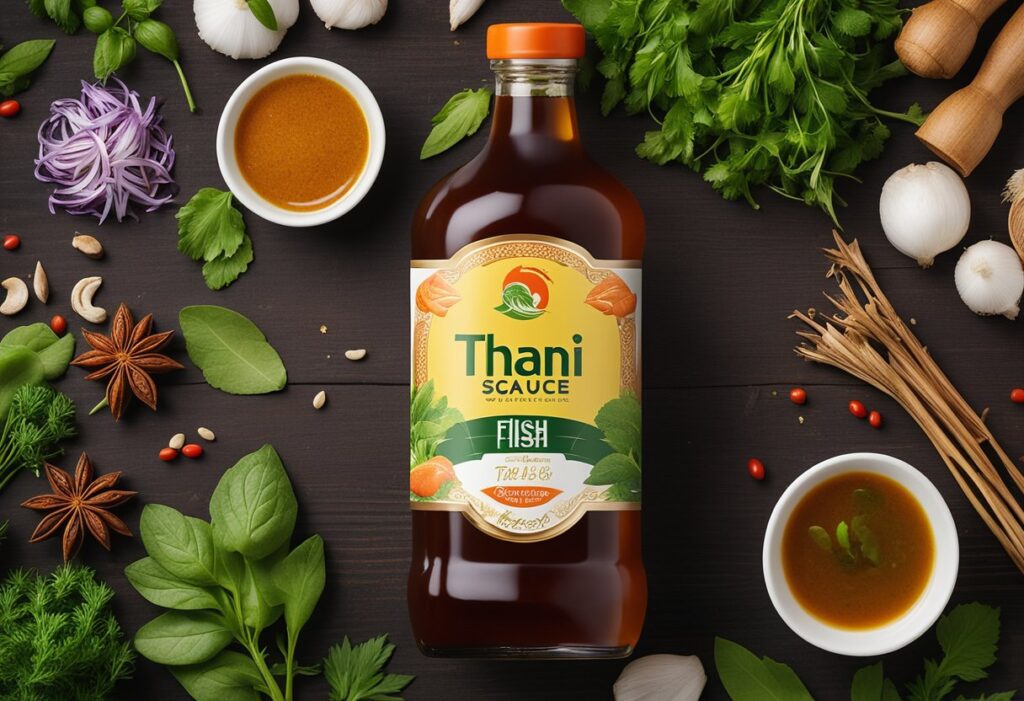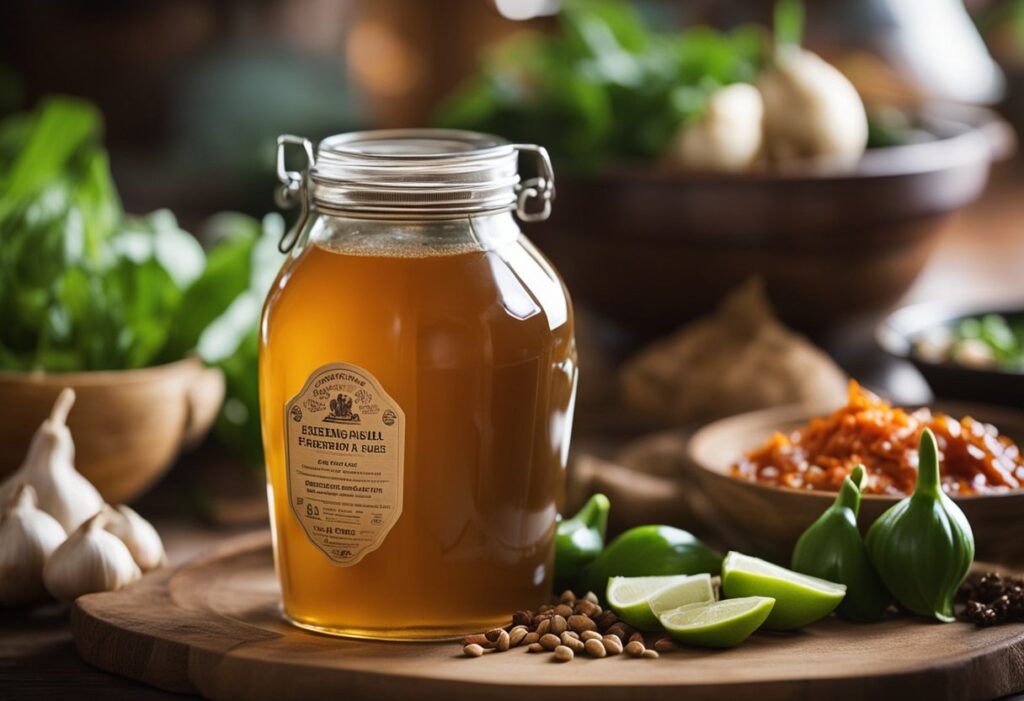Thai fish sauce, also known as nam pla, is a staple ingredient in Thai cuisine. It is a pungent, salty, and umami-rich liquid made from fermented fish. Thai fish sauce is used in a variety of dishes, from soups and curries to stir-fries and dipping sauces.

The history of Thai fish sauce dates back to ancient times when it was used as a preservative for fish. Over time, it became a popular condiment and ingredient in Thai cuisine. Today, Thai fish sauce is not only used in Thailand but also in many other Southeast Asian countries and is gaining popularity in the Western world. Its unique flavor and versatility make it a must-have ingredient in any Thai kitchen.
History of Thai Fish Sauce

Thai fish sauce, also known as nam pla, is a staple ingredient in Thai cuisine that has been used for centuries. The sauce is made by fermenting fish with salt and allowing it to mature for several months. It is often used as a seasoning or condiment in dishes such as stir-fries, curries, and soups.
The origins of fish sauce can be traced back to ancient Rome, where a similar sauce known as garum was widely used. Fish sauce then spread to other parts of the world, including Southeast Asia, where it became an essential ingredient in many local cuisines.
In Thailand, fish sauce has been used since the Sukhothai period (1238-1438 AD). The sauce was initially made by fishermen who used the leftover fish to create a salty liquid that could be used to flavor their food. Over time, the sauce became more refined and was used in a variety of dishes.
Today, there are many different brands of fish sauce available in Thailand, each with its own unique flavor and aroma. Some of the most popular brands include Tiparos, Squid, and Golden Boy. Thai fish sauce is also exported to other countries and is widely used in Southeast Asian cuisine.
Production Process
Ingredients
Thai fish sauce is made from a combination of fish and salt. The most commonly used fish for making fish sauce in Thailand is anchovy, but other small fish such as mackerel and sardines can also be used. The salt used in the production process is usually sea salt, which is readily available in Thailand.
Fermentation
The fish and salt are mixed together in large vats and left to ferment for several months. During this time, the fish undergoes a natural enzymatic process that breaks down the proteins and creates a liquid known as fish sauce. The fermentation process is closely monitored to ensure that the fish sauce reaches the desired flavor and aroma.
Aging
After the fermentation process is complete, the fish sauce is aged for several months to further develop its flavor. During this time, the fish sauce is stored in large wooden barrels, which allow it to breathe and develop a complex flavor profile.
Bottling
Once the aging process is complete, the fish sauce is bottled and labeled for distribution. The bottles are typically made of glass or plastic and come in a variety of sizes, from small individual servings to large bottles for use in commercial kitchens.
Overall, the production process for Thai fish sauce is a time-consuming and labor-intensive process that requires careful attention to detail and a deep understanding of the fermentation and aging process. The end result is a flavorful and versatile condiment that is a staple in Thai cuisine.
Culinary Uses

Thai fish sauce is a versatile condiment that adds depth and umami flavor to a wide variety of dishes. It is a staple ingredient in Thai cuisine and is also used in other Southeast Asian cuisines. In this section, we will explore the culinary uses of Thai fish sauce.
Traditional Thai Dishes
Thai fish sauce is an essential ingredient in many traditional Thai dishes, such as Pad Thai, Tom Yum soup, and Green Papaya Salad. It is also used in curries, stir-fries, and marinades. In these dishes, fish sauce is used to add saltiness, umami flavor, and depth to the dish. It is often used in combination with other ingredients such as chili peppers, garlic, and lime juice to create a complex and balanced flavor profile.
Modern Cooking Applications
In recent years, Thai fish sauce has gained popularity among chefs and home cooks outside of Southeast Asia. It is used in modern cooking applications such as dressings, marinades, and sauces. Fish sauce is a great substitute for soy sauce or Worcestershire sauce in many recipes. It can also be used in place of salt to add depth and umami flavor to dishes.
Thai fish sauce is a versatile ingredient that can be used in a wide variety of dishes. Its unique flavor profile adds depth and complexity to any dish. Whether you’re cooking traditional Thai dishes or experimenting with modern cooking applications, fish sauce is a must-have ingredient in your pantry.
Flavor Profile and Varieties

Thai Fish Sauce is a staple ingredient in Thai cuisine, adding a unique umami flavor to dishes. It is made from fermented fish and has a salty, savory taste that is both pungent and aromatic. The sauce is a translucent reddish-brown liquid with a thin consistency.
Taste Characteristics
The flavor of Thai Fish Sauce can be described as a combination of salty, sweet, and sour notes, with a distinct fishy taste. The sauce has a strong aroma that can be overpowering if used in excess. When used in moderation, it adds depth and complexity to dishes, enhancing the natural flavors of the ingredients.
Regional Variations
There are several regional variations of Thai Fish Sauce that differ in taste and color. The most popular varieties are:
- Nam Pla – This is the most common type of fish sauce, made from anchovies and salt. It has a strong salty flavor and is used in a variety of dishes, including soups, curries, and stir-fries.
- Pla Ra – This is a fermented fish sauce that is popular in Northeastern Thailand. It has a stronger, more pungent flavor than Nam Pla and is often used in spicy salads.
- Kapi – This is a shrimp paste that is used as a substitute for fish sauce in some dishes. It has a distinct, earthy flavor and is often used in chili pastes and dips.
Thai Fish Sauce is a versatile ingredient that can be used in a variety of dishes. It is an essential component of many Thai recipes and is a must-have in any Thai pantry.
Nutritional Information
Thai fish sauce is a condiment that is used in many Thai dishes. It is made from fermented fish and salt, and it is known for its strong, salty flavor. While it is not typically used in large quantities, it is important to understand the nutritional information of fish sauce.
A serving size of fish sauce is typically one tablespoon (15 ml). In this serving size, there are approximately 10 calories and 1.5 grams of sodium. While the calorie count is low, the sodium content is quite high. In fact, one tablespoon of fish sauce provides 60% of the recommended daily intake of sodium.
Fish sauce is also a source of protein, with approximately 1 gram of protein per tablespoon. However, it is not a significant source of other nutrients such as vitamins or minerals.
It is important to note that fish sauce is high in sodium and should be used in moderation, especially for individuals with high blood pressure or other health conditions that require a low-sodium diet. It is also important to choose a high-quality fish sauce that does not contain added sugars or preservatives.
Overall, fish sauce can be a flavorful addition to Thai dishes, but it should be used in moderation due to its high sodium content.
Storage and Shelf Life
Thai fish sauce is a highly concentrated and salty liquid that can last for a long time if stored properly. It is important to keep it away from direct sunlight and high temperatures, as heat and light can cause the sauce to spoil and lose its flavor over time.
To ensure the longevity of Thai fish sauce, it is best to store it in a cool, dry place, such as a pantry or cupboard. Once opened, the sauce should be refrigerated to maintain its freshness and prevent bacterial growth. It is recommended to consume the sauce within 6 months of opening, but it can still be safe to use beyond that time frame if it has been stored properly.
One way to extend the shelf life of Thai fish sauce is to transfer it to a smaller container, such as a glass bottle or jar, and keep the original bottle tightly sealed. This helps to reduce the amount of air exposure and slows down the oxidation process, which can cause the sauce to become rancid.
In summary, proper storage and handling of Thai fish sauce is crucial to maintain its quality and flavor. By following these simple tips, one can enjoy the full potential of this versatile condiment for a longer period of time.
- Store in a cool, dry place
- Refrigerate after opening
- Consume within 6 months of opening
- Transfer to a smaller container to reduce air exposure
Pairing with Other Ingredients
Complementary Flavors
Thai fish sauce is a versatile ingredient that can be paired with a variety of complementary flavors to enhance the taste of a dish. Some of the most popular ingredients that go well with fish sauce are garlic, lime juice, chilies, and sugar. These ingredients help to balance the strong flavor of fish sauce and add depth to a dish.
Garlic is a natural pairing with fish sauce as it helps to mellow out the saltiness of the sauce. Lime juice adds a tangy and acidic flavor that complements the umami taste of fish sauce. Chilies add a spicy kick that balances the sweetness of the sauce, while sugar helps to cut through the saltiness and bring out the other flavors.
Contrasting Flavors
In addition to complementary flavors, Thai fish sauce can also be paired with contrasting flavors to create a unique and interesting taste. Some contrasting flavors that work well with fish sauce include vinegar, soy sauce, and ginger.
Vinegar adds a sour taste that contrasts with the saltiness of fish sauce. Soy sauce also has a salty flavor but is less pungent than fish sauce, making it a good choice for balancing out the flavor. Ginger adds a spicy and slightly sweet taste that contrasts with the umami flavor of fish sauce.
When pairing fish sauce with contrasting flavors, it is important to use them in moderation to avoid overwhelming the taste of the dish. By experimenting with different ingredients and flavors, you can create a delicious and unique dish that highlights the taste of Thai fish sauce.
Cultural Significance
Thai Fish Sauce, also known as nam pla, is a staple ingredient in Thai cuisine and has been for centuries. Its cultural significance in Thai cooking is undeniable, as it is used in a wide variety of dishes, from soups and curries to salads and stir-fries.
Fish sauce has a long history in Southeast Asia, with evidence of its use dating back to ancient times. In Thailand, it is believed that fish sauce was first introduced by the Mon people, who migrated from what is now Myanmar. Over time, it became an essential ingredient in Thai cuisine and is now considered one of the country’s most important condiments.
The production of fish sauce is also deeply ingrained in Thai culture, with many families and communities still making their own versions of the sauce using traditional methods. The process involves fermenting small fish, usually anchovies or mackerel, with salt in large vats for several months. The resulting liquid is then strained and bottled, ready to be used in cooking.
In addition to its culinary uses, fish sauce also holds cultural significance in Thailand’s Buddhist traditions. It is often used as an offering to Buddhist monks during religious ceremonies and is believed to bring good luck and prosperity.
Overall, Thai Fish Sauce is a vital component of Thai cuisine and culture, with a rich history and deep cultural significance. Its unique flavor and versatility make it a beloved ingredient in Thai cooking, both in Thailand and around the world.
Purchasing Tips
When purchasing Thai fish sauce, there are a few things to keep in mind to ensure that you are getting a high-quality product that will enhance the flavor of your dishes.
First, look for fish sauce that is made from anchovies, as this is the traditional fish used in Thai fish sauce and will provide the most authentic flavor. Avoid fish sauce that is made from other types of fish, as they may have a different taste.
Next, check the label for the salt content. A good quality fish sauce should have a high salt content, as this helps to preserve the sauce and gives it a longer shelf life. However, be wary of fish sauce that is excessively salty, as this can overpower the other flavors in your dish.
It is also important to pay attention to the color of the fish sauce. A darker color usually indicates a stronger, more intense flavor, while a lighter color may be milder and more suitable for delicate dishes.
Finally, consider purchasing fish sauce from a reputable brand that uses traditional methods to produce their sauce. This can ensure that you are getting a high-quality product that has been made with care and attention to detail.
Authenticity and Quality Assessment
Thai fish sauce is a staple ingredient in Thai cuisine, and its authenticity and quality are crucial to the taste of the dishes it is used in. To ensure that the fish sauce is authentic and of high quality, several factors need to be considered.
Firstly, the ingredients used to make the fish sauce should be of high quality. Traditionally, Thai fish sauce is made using anchovies, salt, and water. The quality of the anchovies used can significantly affect the taste and aroma of the fish sauce. The anchovies should be fresh and of a particular size to ensure that the fish sauce is of high quality.
Secondly, the fermentation process is crucial in determining the authenticity and quality of the fish sauce. The fermentation process should be carried out in a controlled environment to ensure that the fish sauce is not contaminated by bacteria or other microorganisms. The duration of the fermentation process can also affect the taste and aroma of the fish sauce.
Thirdly, the salt content of the fish sauce is also a crucial factor in determining its quality. The salt should be of high quality and used in the right proportion to ensure that the fish sauce is not too salty or too bland.
To assess the quality of Thai fish sauce, several sensory tests can be carried out. The color, aroma, and taste of the fish sauce can be evaluated to determine its quality. The fish sauce should have a clear, amber color, a rich aroma, and a savory taste.

